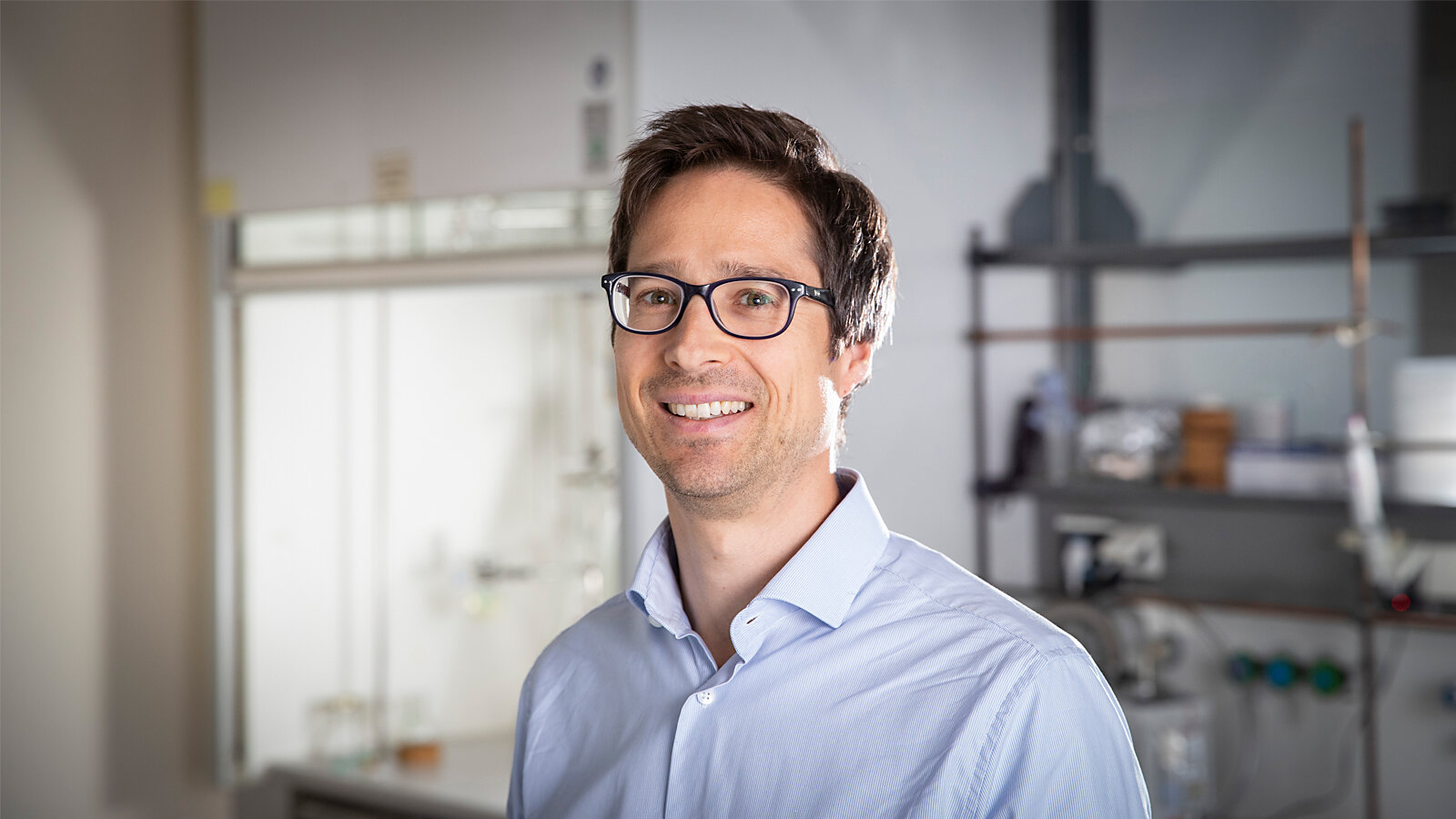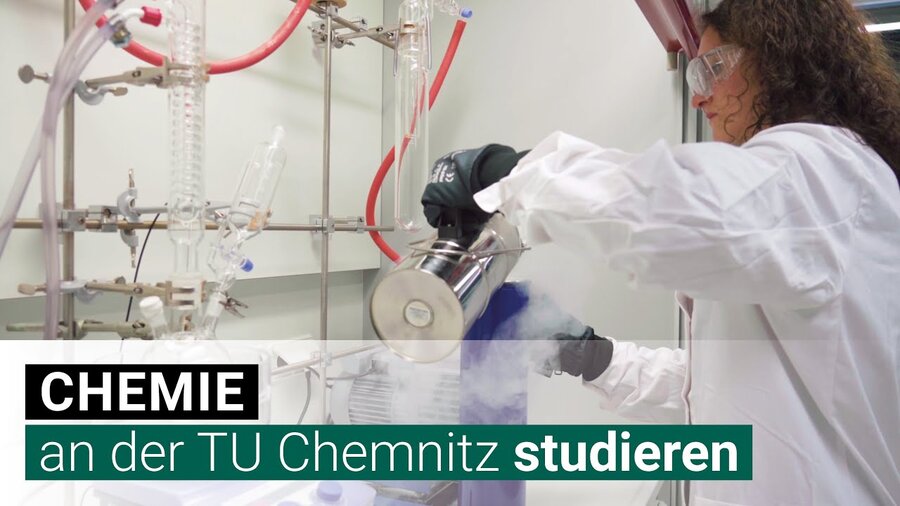"I would like to help significantly reduce the production costs of hydrogen and establish hydrogen as an energy source more quickly"
Polymer chemist Prof. Dr. Michael Sommer in an interview about the consequences of climate change and what contribution the Institute of Chemistry at Chemnitz University of Technology is making to the energy transition
-

Prof. Dr. Michael Sommer's research at Chemnitz University of Technology includes more efficient ways of producing hydrogen. Photo: Jacob Müller
Prof. Dr. Michael Sommer, head of the Professorship of Polymer Chemistry at Chemnitz University of Technology, and his colleagues at the Institute of Chemistry have reorganized their staff in recent years. Among other things, the scientists are researching materials for electrocatalytic processes for the production of sustainable energy sources. This includes, for example, alkaline membrane electrolysis [BB1] as a potential future technology that can make the production of green hydrogen much simpler and cheaper. In the interview, Michael Sommer talks about his research and what contribution it should make to the energy transition in the context of climate change.
Prof. Sommer, Germany and the world are facing enormous challenges in the transition from fossil to sustainable energy sources such as green hydrogen. Where do you currently see the greatest challenges?
First of all, the most important thing is to achieve the goal of climate-neutral electricity production by means of photovoltaic and wind power plants as quickly as possible in order to significantly reduce CO2 emissions and, of course, to become independent of coal, oil and gas. Here, Germany is currently lagging behind its self-imposed targets, because by signing the Paris Climate Agreement, the German Bundestag has committed itself to meeting the 1.5-degree target, which…
…experts such as Prof. Stefan Rahmstorf of the Potsdam Institute for Climate Impact Research no longer consider realistic.
As things stand, the 1.5-degree target is no longer tenable. However, the consequences are already serious and will affect future generations in many areas. My impression is also that many people are not yet aware of the consequences of the climate crisis in its full scope. The problem is also the time lag: what we are currently seeing in terms of droughts, heat waves, forest fires, floods and other dramatic consequences corresponds to just over 1 degree of warming. If we are now heading for 3 degrees and more, we will not see the impact of our current actions for many years. Then you will probably wish you had acted differently now. This must be kept in mind when discussing all currently possible measures. The good news is that sun and wind are available free of charge, and photovoltaic and wind power plants have long been tried and tested. But they must be expanded as quickly as possible.
What is the problem with widespread use?
We have an implementation problem here that has long been thwarted by a lack of political will, legal requirements and formalisms. As a result, large CO2 savings potentials unfortunately remain unused. Much more needs to happen here more quickly. What is needed beyond that, for example for energy storage, the transport sector or even industry, must be served by climate-neutral energy sources such as methanol or hydrogen. However, these technologies still need to be further scaled up, optimized and, above all, made more cost-effective - and we are working on this. But there are also other chemical compounds that are being discussed as fuels.
For example, e-fuels?
Yes, e-fuels are fuels that can be refueled at the pump like gasoline or diesel. From a synthetic perspective, there are several ways to produce them, with varying degrees of advancement. E-fuels can be made from water and CO2, or from renewable resources. This makes them CO2-neutral at best or in competition with food production at worst.
Can e-fuels make a difference in the mobility transition?
The first variant, that is, production from water and CO2, sounds attractive at first, but it has a very poor energy balance and makes e-fuels very expensive. The decisive factor for the balance is, for example, where the electricity for production comes from. This makes them interesting for shipping and air transport, but makes no sense for automotive transport. It is even feared that the increased use of e-fuels will delay the phase-out of fossil fuels. Therefore, the public discussion about e-fuels seems to me to be more of a pseudo debate suggesting that we can continue as before. This distracts from the obvious solutions and missed opportunities. What we need now is not so much technological openness, but the immediate expansion of photovoltaics, wind power and electromobility.
When you argue for less technology openness, do you also mean the use of plants that can filter CO2 from the atmosphere and store it?
The idea of negative CO2 emissions by filtering carbon dioxide out of the atmosphere or, even better, out of, for example, production plants where it is concentrated is interesting. This is known as direct air capture. Another process is the injection of CO2 under pressure into rock strata. The important difference of direct air capture is that CO2 is bound and is available for other processes, meaning that it can be transferred into a cycle. Since emissions cannot be completely avoided in the long term this process could then make a contribution. In the short term, however, this will by no means enable us to reduce CO2 emissions as massively as is necessary. We also have to take a closer look here: How much CO2 can be captured in this way and what are the costs involved? Where do the materials needed for such plants come from and, above all, the green electricity that is a crucial prerequisite? It is much easier, cheaper and, above all, faster to avoid CO2 emissions through climate-neutral electricity production and to replace fossil fuels with hydrogen in areas where chemical energy sources are still needed. All in all, it seems to make sense to have this technology ready when far-reaching emission reductions have already taken place. By 'less technology openness', therefore, we do not mean a general rejection of one technology or another, but rather fewer pseudo debates that lead us away from the most urgent and simplest solutions. By the way, plants automatically store CO2 for us through photosynthesis. In this debate, we should therefore not forget the health of our forests, which is not particularly good either.
In your opinion, are there other energy sources or solutions to climate change that have perhaps been neglected in the discussion so far?
I think we talk too often about things that distract us. I can only recommend reading the status report of the United Nations Intergovernmental Panel on Climate Change and thinking about what is in store for us and, above all, for future generations. This has nothing to do with scaremongering, but with raising awareness of the facts. Those who understand the implications and, above all, the urgency of this report will recognize the universal responsibility of each individual to act. This can be done at very different levels - each according to his or her own capabilities. In addition to the political level, the first step for me is to intensify the discussion among the entire population - based on facts and free of disinformation.
You are a polymer chemist. How can your field make a concrete contribution to shaping the energy transition?
I would like to help significantly reduce the production costs of hydrogen and thus help establish hydrogen as an energy source more quickly. One promising solution is alkaline membrane electrolysis, which has made quite astonishing progress in the last decade. Compared to established processes such as alkaline electrolysis or acidic membrane electrolysis, alkaline membrane electrolysis can use higher current densities and, at the same time, catalysts that are free of precious metals.
What does this process mean in concrete terms for hydrogen use in everyday life?
Alkaline membrane electrolysis, in combination with established processes, has the potential to significantly reduce the cost of hydrogen production and thus make it more widely available. For example, for industry or the transport sector, where electric drives are less suitable. From a scientific perspective, for example, tailor-made membrane materials are needed that show very good long-term stability in the alkaline range and at the same time fulfill a list of other properties. This is challenging and exciting at the same time, and I am particularly pleased that young people can be inspired by this topic.
Does research into sustainable energy sources also play a role beyond your department at the Institute of Chemistry at Chemnitz University of Technology?
Of course! Many professorships are related to this topic. As far as the Institute of Chemistry is concerned, we have recently been able to successfully position the faculty for the future by making strategic new appointments. We are intensively researching the topics that are relevant for the energy transition, such as hydrogen and other energy sources, but also catalysis and green chemistry. At the same time, we guarantee our chemistry students an outstanding education. Shaping the energy transition also means making the contribution of chemistry clear to young people. Therefore, I can only sincerely recommend that all young people who are interested in chemistry and the natural sciences study chemistry at Chemnitz University of Technology. We offer excellent study conditions as well as staff-student ratios and opportunities to obtain information are available in advance.
Thank you very much for the interview.
(Translation: Brent Benofsky)
Multimedia:

Embedding of external provider's content
The display of embedded external content of the platform YouTube on the website of Chemnitz University of Technology and therefore the connection to the external server of the platform provider requires your consent before. First when you have given your consent for this provider (personal) data will be transmitted to the external server operator so that the content display can take place. The operator may be located in a non-European country.
With submitting the button you agree formally and voluntarily that you personal data as described in the Data Protection Policy with its there specified purposes will be processed for embedding of external content on the website of Chemnitz University of Technology. Your consent can be revoked separately or as a whole at any time without undue disadvantages for the future.
Matthias Fejes
20.07.2022




